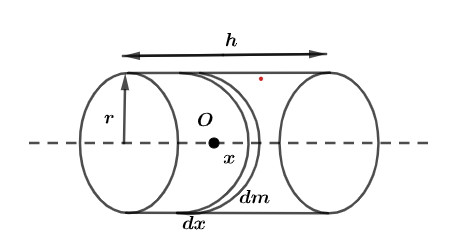Question
Question: What is the moment of inertia of a solid cylinder of radius \(r\), along its height? (a) \(m{{r}^{...
What is the moment of inertia of a solid cylinder of radius r, along its height?
(a) mr2
(b) 2mr2
(c) 52mr2
(d) 5mr2
Solution
- Hint: To find the moment of inertia of the solid cylinder along its height, we will consider the axis passing through the cylinder parallel to its height and then we will consider the cylinder made up of multiple discs. So, we will find the moment of inertia of the disc which can be given by the formula, 2mr2. Then integrating the term, we will find the moment of inertia of the cylinder.
Formula used: 2mr2
Complete step-by-step solution:
In question we are asked to find the moment of inertia of solid cylinder along its height, so first of all we will draw a figure for our simplicity,

Now, as shown in figure we will consider a disc of mass dm and thickness dx at distance x from point O.
Now, the mass per unit length of the cylinder can be given as, hm.
Mass of disc (M1)=hm×dx (i)
Now, the moment of inertia of the disc can be given by the formula, 21mr2.
So, the moment of inertia of disc of mass M1 and along-x axis can be given as, 21M1R2 ………………….(ii)
On substituting the value from equation (i) and considering radius as r instead of R, we will get,
21hmr2dx …………………..(iii)
Now, the moment of inertia of cylinder can be obtained by integrating the expression (iii), which can be given mathematically as,
Moment of inertia of solid cylinder =∫21hmr2dx
Now, the limit of integration will be −2h to 2h, so on applying limits to the integration we will get,
M. O. I. =2−h∫2h21hmr2dx
⇒[21hmr2x]2−h2h
⇒[21hmr2[2h−(−2h)]]
⇒[21hmr222h]
⇒MOI=[2mr2]
So, the moment of inertia of the cylinder along its height h is 2mr2.
Hence, option (b) is correct.
Note: Student might make mistake in taking the limits, they might take limits from 0 to h instead of −2h to 2h and due to that the answer may be right but it is wrong method to solve as we are considering the point O at the centre of axis, we have to take limits as positive and negative instead of considering the initial limit a zero and final as h because in that way our point O will be at the beginning of cylinder instead of centre. So, students must be careful while considering the limits in such problems to avoid mistakes.
